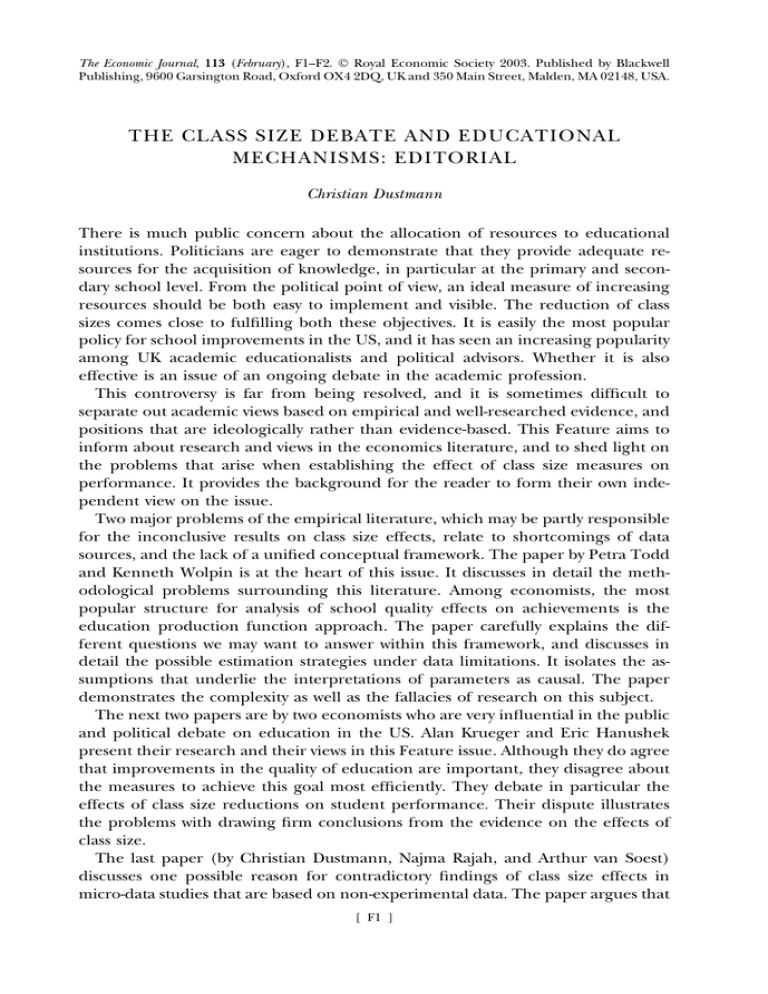The Economic Journal, 113 (February), F1–F2. Ó Royal Economic Society... Publishing, 9600 Garsington Road, Oxford OX4 2DQ, UK and 350...
advertisement

The Economic Journal, 113 (February), F1–F2. Ó Royal Economic Society 2003. Published by Blackwell Publishing, 9600 Garsington Road, Oxford OX4 2DQ, UK and 350 Main Street, Malden, MA 02148, USA. THE CLASS SIZE DEBATE AND EDUCATIONAL MECHANISMS: EDITORIAL Christian Dustmann There is much public concern about the allocation of resources to educational institutions. Politicians are eager to demonstrate that they provide adequate resources for the acquisition of knowledge, in particular at the primary and secondary school level. From the political point of view, an ideal measure of increasing resources should be both easy to implement and visible. The reduction of class sizes comes close to fulfilling both these objectives. It is easily the most popular policy for school improvements in the US, and it has seen an increasing popularity among UK academic educationalists and political advisors. Whether it is also effective is an issue of an ongoing debate in the academic profession. This controversy is far from being resolved, and it is sometimes difficult to separate out academic views based on empirical and well-researched evidence, and positions that are ideologically rather than evidence-based. This Feature aims to inform about research and views in the economics literature, and to shed light on the problems that arise when establishing the effect of class size measures on performance. It provides the background for the reader to form their own independent view on the issue. Two major problems of the empirical literature, which may be partly responsible for the inconclusive results on class size effects, relate to shortcomings of data sources, and the lack of a unified conceptual framework. The paper by Petra Todd and Kenneth Wolpin is at the heart of this issue. It discusses in detail the methodological problems surrounding this literature. Among economists, the most popular structure for analysis of school quality effects on achievements is the education production function approach. The paper carefully explains the different questions we may want to answer within this framework, and discusses in detail the possible estimation strategies under data limitations. It isolates the assumptions that underlie the interpretations of parameters as causal. The paper demonstrates the complexity as well as the fallacies of research on this subject. The next two papers are by two economists who are very influential in the public and political debate on education in the US. Alan Krueger and Eric Hanushek present their research and their views in this Feature issue. Although they do agree that improvements in the quality of education are important, they disagree about the measures to achieve this goal most efficiently. They debate in particular the effects of class size reductions on student performance. Their dispute illustrates the problems with drawing firm conclusions from the evidence on the effects of class size. The last paper (by Christian Dustmann, Najma Rajah, and Arthur van Soest) discusses one possible reason for contradictory findings of class size effects in micro-data studies that are based on non-experimental data. The paper argues that [ F1 ] F2 THE ECONOMIC JOURNAL [ F E B R U A R Y 2003] one should be cautious in accepting outcomes of non-experimental studies that state that there are no class size effects on wages or other later outcomes. Class size effects may not be large enough to be detected by direct regressions with data sets of the size usually available for this type of studies. The paper specifies a particular channel by which class size may affect future wages: Its effects on the school continuation decision. Specifying the process by which class size affects wages results in more efficient estimates. Based on non-experimental micro data for the UK that is unusually rich in terms of background information, the paper finds significant effects of class size on later wages, via its effect on the school continuation decision. In contrast, in standard reduced form wage equations that do not exploit the additional information or the school continuation decision, the class size effects on wages are not precisely estimated and insignificant. Which conclusions can we draw from the debate laid out in this issue? The evidence on class size effects on later outcomes, based on non-experimental data, seems ambiguous. This ambiguity is related to the complexity of the problem, and, at the same time, the paucity of data available for analysis. The selection problem of pupils into classes of different size is complex, and appropriate modelling of this process requires a lot of information. Lack of information in data has then to be substituted by assumptions that are non-testable, and may contaminate the results. Furthermore, class size effects are very small, and therefore difficult to detect in small data sets. Experimental data may help to avoid many of these shortcomings. University College London and Institute for Fiscal Studies Ó Royal Economic Society 2003






